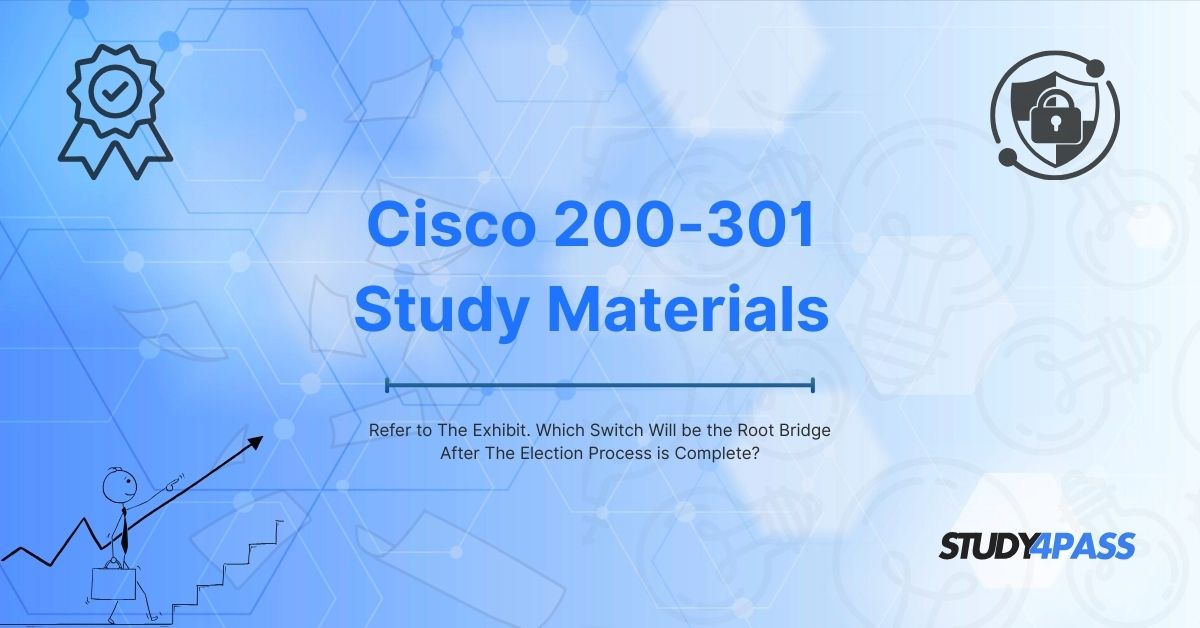Introduction
In Cisco networking, the Spanning Tree Protocol (STP) plays a crucial role in preventing loops in a switched network while ensuring redundancy. One of the fundamental concepts in STP is the election of a Root Bridge, which acts as the reference point for all other switches in the network.
This article will explore how the Root Bridge election process works, analyze a given exhibit (scenario-based), determine which switch becomes the Root Bridge, and explain the key factors influencing this decision. Additionally, we will discuss the significance of this topic for the CCNA 2 v7 Checkpoint Exam and the Cisco 200-301 Certification. Finally, we will highlight how Study4Pass can help aspiring network engineers master these concepts effectively.
Understanding the Root Bridge Election Process
1. What is the Root Bridge?
The Root Bridge is the central switch in a Spanning Tree Protocol (STP) topology. All other switches (non-root bridges) calculate the shortest path to the Root Bridge to avoid loops while maintaining network connectivity.
2. How is the Root Bridge Elected?
The election process is based on the following criteria in order:
- Lowest Bridge ID (BID) – The BID consists of:
- Bridge Priority (default: 32768, configurable in multiples of 4096)
- MAC Address (tiebreaker if priorities are equal)
3. Default STP Behavior
- If no switch is manually configured with a priority, the switch with the lowest MAC address becomes the Root Bridge.
- Network administrators often manually set a preferred Root Bridge by lowering its priority (e.g., 4096).
Analyzing the Exhibit: Which Switch Becomes the Root Bridge?
(Note: Since we don’t have an actual exhibit, we will assume a common CCNA exam scenario.)
Sample Scenario:
Consider the following three switches in a network:
|
Switch |
Priority |
MAC Address |
|
Switch A |
32768 |
00:1A:2B:3C:4D:11 |
|
Switch B |
28672 |
00:1A:2B:3C:4D:22 |
|
Switch C |
32768 |
00:1A:2B:3C:4D:33 |
Election Process:
-
Compare Priorities:
- Switch B has the lowest priority (28672), so it wins the election.
- If priorities were equal (e.g., all 32768), the switch with the lowest MAC address (Switch A) would win.
- Switch B will be the Root Bridge because it has the lowest Bridge ID (priority + MAC).
Why is This Important for the CCNA 2 v7 and Cisco 200-301 Exam?
Understanding STP and Root Bridge election is critical for:
Preventing network loops while maintaining redundancy.
Optimizing traffic paths in a switched network.
Troubleshooting STP-related issues (e.g., suboptimal Root Bridge selection).
Common Exam Questions:
- "Which switch becomes the Root Bridge if all have default priorities?"
- Answer: The one with the lowest MAC address.
- Answer: Lower its priority (spanning-tree vlan 1 priority 4096).
- Answer: A new election occurs, and the next best switch takes over.
How Study4Pass Help You Master STP and CCNA Concepts?
Study4Pass is a leading platform for IT certification preparation, offering:
- Detailed CCNA 2 v7 Lab Solutions – Step-by-step explanations for STP configurations.
- Real Exam Simulations – Practice questions mimicking Cisco’s style.
- Interactive STP Demos – Visual learning aids for Root Bridge elections.
- Expert Guidance – Tips from certified professionals to avoid common mistakes.
By leveraging Study4Pass, students gain confidence in tackling STP-related questions in the Cisco 200-301 exam and real-world networking scenarios.
Final Words
The Root Bridge election in STP is determined by the lowest Bridge ID (priority + MAC address). In our example, Switch B became the Root Bridge due to its lower priority. Mastering this concept is essential for the CCNA 2 v7 Checkpoint Exam and Cisco 200-301 Certification.
For in-depth tutorials, exam strategies, and hands-on labs, Study4Pass provides the best resources to ensure your success in networking certifications.
Special Discount: Offer Valid For Limited Time “Cisco 200-301 Exam Materials”
Sample Questions for the Cisco CCNA 200-301 Exam
Actual exam question from Cisco's 200-301 Study Guide.
1. Which switch will become the root bridge in a spanning-tree election process if all switches have the same priority?
a) The switch with the lowest MAC address
b) The switch with the highest MAC address
c) The switch with the fastest uplink port
d) The switch with the most ports
2. What is the primary factor in determining the root bridge in STP?
a) Port speed
b) Bridge ID (Priority + MAC Address)
c) Uptime of the switch
d) Number of connected devices
3. If two switches have the same priority value, how is the root bridge elected?
a) The switch with the higher MAC address wins
b) The switch with the lower MAC address wins
c) The switch with more active interfaces wins
d) The switch with the fastest CPU wins
4. How can a network administrator influence the root bridge election?
a) By changing the switch’s MAC address
b) By adjusting the STP priority value
c) By disabling unused ports
d) By increasing the switch’s uplink speed
5. What happens if the current root bridge fails in an STP topology?
a) The network goes down until the root bridge recovers
b) A new root bridge is elected based on the remaining switches' Bridge IDs
c) STP recalculates but keeps the same root bridge
d) All switches become root bridges temporarily


